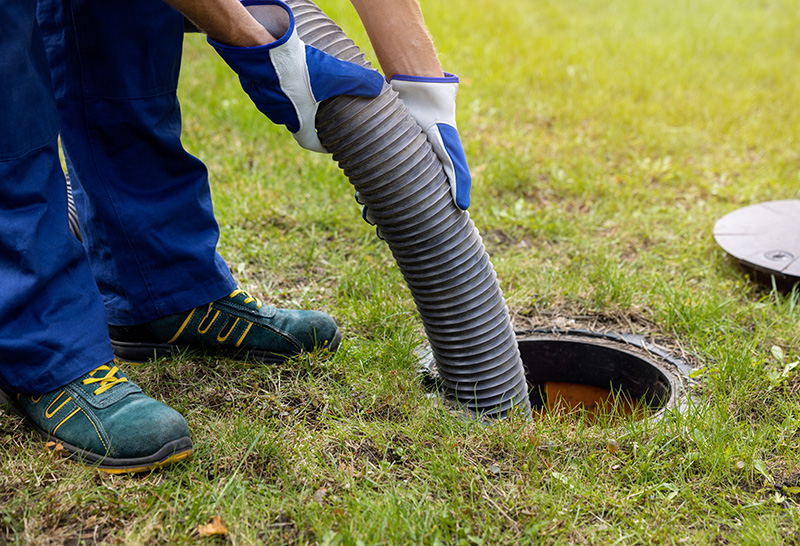The question “Is my septic tank full?” is one of the most common inquiries we receive from homeowners in Northern Virginia. However, what people often mean by “full” can be a bit misleading. A septic tank is almost always “full” of liquid, as it’s designed to continuously process wastewater. The real concern is the accumulation of solids (sludge and scum) that indicate it’s time for a professional pumping. Understanding this distinction is key to proper septic maintenance.
Debunking Myths About Septic Tank Levels
Let’s clarify what “full” truly means in the context of a septic system:
- Myth 1: A septic tank should be empty or partially empty.
- Reality: This is false. A functioning septic tank is always full of liquid, continuously receiving wastewater from your home. This liquid (effluent) then flows out to the drain field for further treatment. The water level in the tank should typically be at the bottom of the outlet pipe. If your tank looks empty, it could indicate a serious leak, which is a significant problem.
- Myth 2: If there’s liquid, the tank isn’t full and doesn’t need pumping.
- Reality: Again, false. The liquid level doesn’t tell the whole story. While the liquid (effluent) constantly flows through, solid waste accumulates over time, forming layers of scum on top and sludge on the bottom. It’s the accumulation of these solid layers, not the liquid level, that determines when a tank needs pumping.
- Myth 3: I’ll know my tank is full when I see water pooling in the yard.
- Reality: While water pooling in the yard is a critical sign of a septic problem, it usually means the problem has advanced beyond just a “full” tank and likely indicates a failing drain field due to excessive sludge carryover. You shouldn’t wait for this severe symptom to consider pumping.
Explaining Normal vs. Problematically Full (Sludge and Scum)
A healthy septic tank operates by separating wastewater into three distinct layers:
- Scum Layer (Top): This layer consists of lighter materials like fats, oils, greases, and soaps that float on the surface.
- Effluent Layer (Middle): This is the clarified liquid that has undergone initial treatment by anaerobic bacteria. It flows out to the drain field.
- Sludge Layer (Bottom): This layer is composed of heavier solids that settle at the bottom of the tank, where they are partially broken down by bacteria.
Normal Fullness: Your septic tank is always full of these three layers, with the effluent constantly flowing out to the drain field. This is how it’s designed to operate in Virginia.
Problematic Fullness (Time for Pumping):
A septic tank is considered “full” in a problematic sense when the accumulated sludge and scum layers become too thick. When these layers take up too much of the tank’s volume, they begin to:
- Reduce Effective Treatment Volume: There’s less space for the effluent to settle and for bacteria to properly treat it.
- Block Outlet Pipes/Baffles: The scum layer can grow so thick that it clogs the outlet baffle, preventing effluent from flowing to the drain field.
- Push Solids to the Drain Field: The most severe consequence. As the sludge layer grows, solids can be forced out of the tank and into the drain field. These solids will clog the soil pores, causing the drain field to fail permanently. This is expensive to fix and replace for Virginia homeowners.
Signs Your Septic Tank is Problematically Full
Don’t rely on visual inspection from the surface. Instead, look for these common warning signs in your Northern Virginia home:
- Slow Drains and Toilets: Water draining slowly from sinks, showers, or toilets, especially if multiple fixtures are affected.
- Gurgling Sounds: Gurgling noises from pipes or toilets after flushing.
- Foul Odors: Persistent sewage smells, either inside your home (from drains) or outside near the septic tank or drain field.
- Lush, Green Grass Over the Tank/Drain Field: While normal grass over a drain field is fine, unusually lush, spongy, or overly green patches of grass can indicate surfacing effluent due to an overloaded or failing system.
- Sewage Backups: The most undeniable sign that your system is critically full or failing.
Great Falls Septic: Your Partner in Regular Maintenance
The most reliable way to determine if your septic tank needs pumping is to have a professional septic service in Northern Virginia, like Great Falls Septic Service, perform an inspection. We can accurately measure the thickness of the scum and sludge layers and recommend pumping based on the actual condition of your tank, typically every 3-5 years for most households. Regular pumping, regardless of perceived fullness, is the cornerstone of long-term septic system health. Contact us today to schedule your septic inspection!


